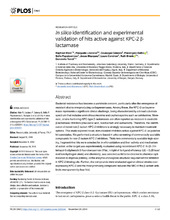| dc.contributor.author | Klein, Raphael | en_US |
| dc.contributor.author | Linciano, Pasquale | en_US |
| dc.contributor.author | Celenza, Guiseppe | en_US |
| dc.contributor.author | Bellio, Pierangelo | en_US |
| dc.contributor.author | Papaioannou, Sofia | en_US |
| dc.contributor.author | Blazques, Jesus | en_US |
| dc.contributor.author | Cendron, Laura | en_US |
| dc.contributor.author | Brenk, Ruth | en_US |
| dc.contributor.author | Tondi, Donatella | en_US |
| dc.date.accessioned | 2019-05-29T07:29:46Z | |
| dc.date.available | 2019-05-29T07:29:46Z | |
| dc.date.issued | 2018-11-29 | |
| dc.Published | Klein, Linciano, Celenza, Bellio, Papaioannou, Blazques, Cendron, Brenk R, Tondi. In silico identification and experimental validation of hits active against KPC-2 β-lactamase. PLoS ONE. 2018;13(11):e0203241 | eng |
| dc.identifier.issn | 1932-6203 | |
| dc.identifier.uri | https://hdl.handle.net/1956/19787 | |
| dc.description.abstract | Bacterial resistance has become a worldwide concern, particularly after the emergence of resistant strains overproducing carbapenemases. Among these, the KPC-2 carbapenemase represents a significant clinical challenge, being characterized by a broad substrate spectrum that includes aminothiazoleoxime and cephalosporins such as cefotaxime. Moreover, strains harboring KPC-type β-lactamases are often reported as resistant to available β-lactamase inhibitors (clavulanic acid, tazobactam and sulbactam). Therefore, the identification of novel non β-lactam KPC-2 inhibitors is strongly necessary to maintain treatment options. This study explored novel, non-covalent inhibitors active against KPC-2, as putative hit candidates. We performed a structure-based in silico screening of commercially available compounds for non-β-lactam KPC-2 inhibitors. Thirty-two commercially available high-scoring, fragment-like hits were selected for in vitro validation and their activity and mechanism of action vs the target was experimentally evaluated using recombinant KPC-2. N-(3-(1H-tetrazol-5-yl)phenyl)-3-fluorobenzamide (11a), in light of its ligand efficiency (LE = 0.28 kcal/mol/non-hydrogen atom) and chemistry, was selected as hit to be directed to chemical optimization to improve potency vs the enzyme and explore structural requirement for inhibition in KPC-2 binding site. Further, the compounds were evaluated against clinical strains overexpressing KPC-2 and the most promising compound reduced the MIC of the β-lactam antibiotic meropenem by four-fold. | en_US |
| dc.language.iso | eng | eng |
| dc.publisher | PLOS | eng |
| dc.rights | Attribution CC BY | eng |
| dc.rights.uri | http://creativecommons.org/licenses/by/4.0 | eng |
| dc.title | In silico identification and experimental validation of hits active against KPC-2 β-lactamase | en_US |
| dc.type | Peer reviewed | |
| dc.type | Journal article | |
| dc.date.updated | 2019-01-24T08:50:35Z | |
| dc.description.version | publishedVersion | en_US |
| dc.rights.holder | Copyright 2018 The Author(s) | |
| dc.identifier.doi | https://doi.org/10.1371/journal.pone.0203241 | |
| dc.identifier.cristin | 1646740 | |
| dc.source.journal | PLoS ONE | |

